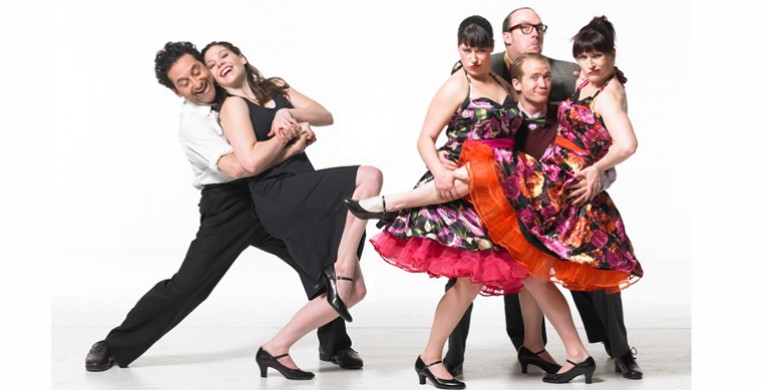There’s much to celebrate and appreciate about Jump Rhythm Jazz Project’s 25th anniversary season (through November 2nd at Stage 773), most of all its founding director, Billy Siegenfeld.
Billy is the heart and soul of Jump Rhythm--everything about him. His delightfully incisive mind, his sense of humor, endearing personality, uniquely energized dance style and quirky imagination, his humanity, the passion he has for life and for art, and his multifarious talents as consummate dancer, musician, poet, actor and storyteller all conspire to make him irresistible on stage.
He incorporates all of these facets into an autobiographic dance/theater elegy to his past in “When Little Enough Is Good Enough” (premiere), a reflective look back on his journey as an artist and a testimony to the aesthetic that emerged from it.
He begins sitting in a folding chair at one side of the stage, but he’s not just sitting, because nothing Billy does on stage, or off I suspect, is just what it seems on the surface. His body has surrendered its energy to the chair, and because energy is what Billy is all about, his momentary capitulation is an organic point of departure for telling the story--through spoken text, movement, dancing, and singing--of his search for his inner pulse.
Oral storytelling ignites a gradual build of energy and transformation and sustains the structural through-line of the piece. His epiphany in his quest, he says, began with a dragonfly, “a messenger of magic” that lights on his arm and stays there for a half hour without fear, because he is still enough to experience it. Before that could happen, however, he had to suffer numerous failed launches in imitation of artists who seemed to be doing something he wanted to do himself.
As a storyteller with the skills of a seasoned actor, he visualizes his experiences through the rhythm of his vocal and body energy. Erupting into physical animation, he paints a vivid picture of the simplicity and stillness that captivated him about Isadora Duncan’s radical departure from theatrical dance conventions. His own early frustrated experiments with stillness lead him to discover “how hard it is to do what’s simple.” His adulation of dancers “who do things ordinary mortals can’t do” led him to “the old razzle dazzle,” which he demonstrates to great effect. When that doesn’t pan out, he takes “a vacation from myself,” turning to a brief fixation with Moby Dick and Ahab’s destructive need for revenge, bringing us full-circle back to the epiphany of the dragonfly and the piece’s climactic episode.
Unfolding as a dream duet with skilled company dancer Jordan Batta as the seductress/personified dragonfly, the captivating emotional tango they dance together becomes an exorcism that delivers Billy back to the chair and the dragonfly. This time, sitting becomes a triumphant submission of willfulness, in contrast to the capitulation at the beginning of the piece.”Thank you, Izzy,” he says, and concludes by singing the Shaker tune, “Simple Gifts,” accompanying himself at an onstage keyboard. He left me wanting to see him dance more. I could have watched and listened to Billy in this wonderful total theater piece all night. One might even dare to wish for its expansion into a full-length evening.
It makes sense that Siegenfeld was a drummer before he began dancing and comes by his obsession with rhythm and jazz first as a musician. “I was used to beating things,” he said in a recent interview. That urge plays out in his movement, with unexpected rhythmic juts and jabs into space, like a prize fighter boxing an internal opponent.
“When Little Enough Is Good Enough” supremely demonstrates Siegenfeld’s impulse-driven visualization of internal rhythm that characterizes his Jump Rhythm (R) technique, where hands, voice, head, and eyes are as rhythmically activated as the feet and legs in expressing the explosive, often unpredictable ebb and flow of human emotion.
Rhythm as catharsis could well be the mantra for the rest of the program, but the “full-bodied rhythm-making” Siegenfeld so magnificently demonstrates in his own performance is not uniformly apparent in his company, nor in all of the choreography on display Friday night.
“No Way Out” (1997) features a light-hearted parody of Broadway dancing set to the music “Broadway” by Henry Woode, Teddy McRae, and Billy Byrd. The company introduces us to the characteristic punch-jab spread-finger hand impulses and sibilant vocalizations of Jump Rhythm, and delivers a series of peppy, period-tinged dance segments and silly character types, but the dancers, excepting Batta and guest tap artists Mark Yonally and Kirsten Uttich, were pale imitations of Siegenfeld. It wasn’t altogether clear if the piece wanted to be just a fun send-up of commercial theatrics or a deeper, more cynical commentary. Its strength lay in Siegenfeld’s skillful manipulation of body rhythms and musical score, which anchored the stage action with something that truly did approach a unity of visual and auditory design. Syncopated sections of the stage divided dancers into groups of counterpoint rhythms in an entertaining tap and soft-shoe mix. Yonally and Uttich’s tap mastery especially delighted in Siegenfeld’s noteworthy integration of complex tap rhythms with the jazz score.
“god of dirt,” (2007), the strongest group piece of the program, featured Siegenfeld in the comedic role of a shnook (a la Woody Allen) who wanders inadvertently into a camp of rabid gypsy dancers. This thoroughly entertaining and hyper-energized folk dance/Jump Rhythm frolic showed the company off to its best advantage, but the highlight was the seething duet between Siegenfeld and the tall blond gypsy queen. Siegenfeld’s use of head, eyes, and hands to achieve both rhythmic design and visual focus was spectacularly funny as well as a terrific example of Jump Rhythm at its creative best.
Siegenfeld’s “Too Close For Comfort” (1998), and company member Kevin Dumbaugh’s “Maybe? No. Yes!” (2012) were also on the program.

